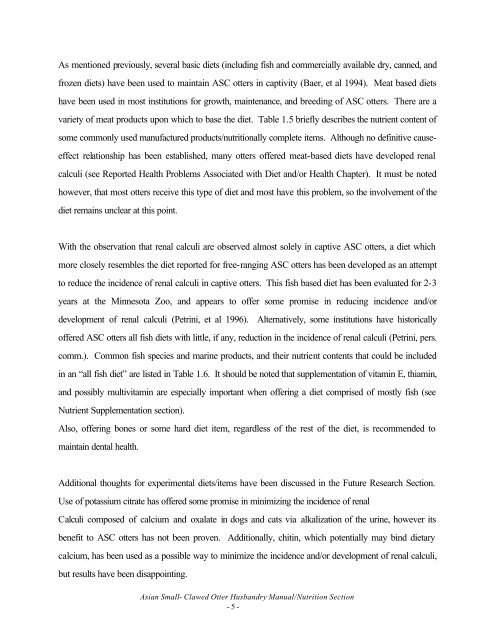Asian Small-Clawed Otter Husbandry Manual (1998)
Asian Small-Clawed Otter Husbandry Manual (1998)
Asian Small-Clawed Otter Husbandry Manual (1998)
You also want an ePaper? Increase the reach of your titles
YUMPU automatically turns print PDFs into web optimized ePapers that Google loves.
As mentioned previously, several basic diets (including fish and commercially available dry, canned, andfrozen diets) have been used to maintain ASC otters in captivity (Baer, et al 1994). Meat based dietshave been used in most institutions for growth, maintenance, and breeding of ASC otters. There are avariety of meat products upon which to base the diet. Table 1.5 briefly describes the nutrient content ofsome commonly used manufactured products/nutritionally complete items. Although no definitive causeeffectrelationship has been established, many otters offered meat-based diets have developed renalcalculi (see Reported Health Problems Associated with Diet and/or Health Chapter). It must be notedhowever, that most otters receive this type of diet and most have this problem, so the involvement of thediet remains unclear at this point.With the observation that renal calculi are observed almost solely in captive ASC otters, a diet whichmore closely resembles the diet reported for free-ranging ASC otters has been developed as an attemptto reduce the incidence of renal calculi in captive otters. This fish based diet has been evaluated for 2-3years at the Minnesota Zoo, and appears to offer some promise in reducing incidence and/ordevelopment of renal calculi (Petrini, et al 1996). Alternatively, some institutions have historicallyoffered ASC otters all fish diets with little, if any, reduction in the incidence of renal calculi (Petrini, pers.comm.). Common fish species and marine products, and their nutrient contents that could be includedin an “all fish diet” are listed in Table 1.6. It should be noted that supplementation of vitamin E, thiamin,and possibly multivitamin are especially important when offering a diet comprised of mostly fish (seeNutrient Supplementation section).Also, offering bones or some hard diet item, regardless of the rest of the diet, is recommended tomaintain dental health.Additional thoughts for experimental diets/items have been discussed in the Future Research Section.Use of potassium citrate has offered some promise in minimizing the incidence of renalCalculi composed of calcium and oxalate in dogs and cats via alkalization of the urine, however itsbenefit to ASC otters has not been proven. Additionally, chitin, which potentially may bind dietarycalcium, has been used as a possible way to minimize the incidence and/or development of renal calculi,but results have been disappointing.<strong>Asian</strong> <strong>Small</strong>- <strong>Clawed</strong> <strong>Otter</strong> <strong>Husbandry</strong> <strong>Manual</strong>/Nutrition Section- 5 -
















